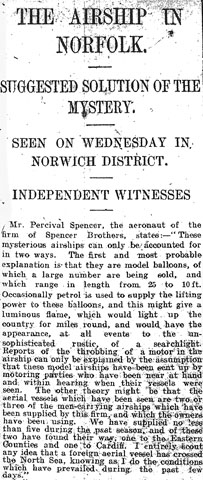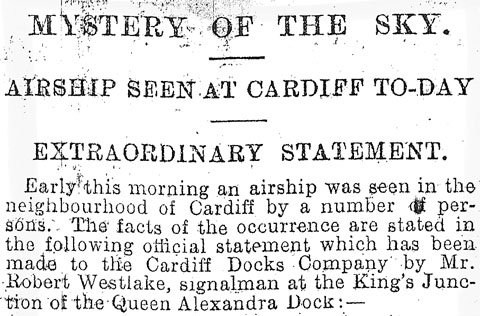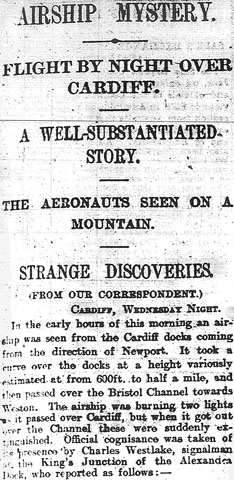
Today is Saturday, when a number of the weeklies in my sample are published. Two of them are clearly sceptical, and don’t devote much space to the mystery airships; one, from the heart of scareship country, is much more open-minded and has half a page of reports and analysis. This is the Norfolk News, which carries accounts (p. 13) from three witnesses who independently saw the airship on Wednesday night. The first is a ‘well-known gentleman’ (unfortunately unnamed) from Wroxham, who had interrupted his motorcycle journey at 11.30pm to look at his headlight, which had gone out. He was dazzled by a ‘flashlight’ shone on him from above. This lasted about half a minute; he could not see the source of the light nor did he hear anything. Nonetheless ‘That it was an airship he has no doubt whatever’. The second witness is Mrs. Turner, of 1 Traverse-street, Catton. Coming home from the theatre at about 11.30pm, ‘a flash of light came on me all of a sudden and made the street look like day’. She heard a ‘noise like the whizzing of wheels’. It was then that she looked up, seeing ‘a big star of light in front and a big searchlight behind’. She did not see the body of the airship, but in her opinion it was flying so low that it would have clipped the top of a nearby school, had it been directly overhead. Two young people nearby also saw it (one said ‘What’s that?’). The third witness is a 21 year from Tharston named Chatten, assistant to J. A. Lammas, a local grocer and draper. He was cycling home when he was dazzled by a light from above: ‘The trees and hedges were lit up brilliantly’. Unlike the other two witnesses, he did see something besides the light, a shape outlined against the night sky:
[…] I saw a long cigar-shaped object, a little thicker at the blunt end than a cigar, come three or four hundred feet above me. It was soaring upwards, the tapering end going foremost, and was moving rapidly in the direction of Norwich. On the under side was what I should call an iron bar, supporting a sort of framework, a yellow light shining at each end. I could not see any men upon the framework, not could I hear any buzzing sound such as a motor would cause […]
The Norfolk News places great stress on the independence of these witnesses:
The Catton observer, who gives her name and address, would not be in the least degree likely to know the Wroxham observer, who bears a well-known name, and who has probably never been in Traverse Street or Waterlook Road in his life.
So, since they move in very different circles — the gentleman motorcyclist is clearly well-to-do, Mrs. Turner is probably working class — there’s no likelihood of collusion. Which is important, because there is a striking similarity between their accounts: in particular, a dazzling flash from above, which is what drew their attention to the ‘airship’ in the first place. Although as a leading article on the same page points out, given that it’s so bright it’s surprising that more people didn’t see it.
This also shows the value of local knowledge; a London newspaper would have no knowledge of who was who in Catton or Wroxham. The Norfolk News also sent its own reporter to interview Chatten. Such local knowledge can unmask hoaxes, too. Apparently Monday’s Daily Express published a letter written by a Major Mayfield, of the House, Pinchbeck Road, Spalding, Lincolnshire. It turns out that ‘the House’ is the local workhouse, and one of the better known ‘inmates’ of the workhouse was a man known as ‘General’ Mayfield. As the Norfolk News puts it, ‘The whole thing is a hoax’. At least we can rule that out in this case!
A local ‘expert’, E. Cæsar Hawkins of Shelton Hall, Long Stratton (who is unknown to me, but seems to at least be familiar with the aviation scene), thinks it may be a real airship, perhaps of the Spencer or Santos-Dumont types. Certainly not ‘a Zeppellin [sic], though I wouldn’t guarantee it for a year’. The editor of the Norfolk News is of the same opinion, calling the notion of a foreign airship a ‘ridiculous explanation’ which ‘Nobody with the slightest acquaintance with the science of aeronautics’ could hold.
Either there is a private inventor experimenting in the Eastern Counties, and endeavouring to keep his location secret; or the airship is an English Government airship undergoing secret trials.
Otherwise it could be ‘contagious imagination’ (as Hawkins puts it). E. B. Nye of Norwich responds to written reports of the Wednesday night sightings (which means he must have been asked to comment, or else had seen something in another local paper) by recounting that he and a friend had seen a brilliant falling star at 11.30pm, the same time as the other sightings:
Had our brains been inoculated with the present airship scare theory, we might even have heard a whizzing noise, and had a searchlight directed upon us.
The Norfolk News summarises many of the other sightings from the last week, and adds a few other new ones: Southend; off Hull (by Belgian fishermen): Lowestoft (a detailed account from several witnesses); Broome (by Capt. Hervey, Local Government Board Inspector for the Eastern District); Yarmouth. To go through them all would be tedious, so I’ll turn to commentary from the other weeklies. The Southampton Times has a regular column called ‘Shafts at random’ by Robin Hood (which I’m guessing is a pseudonym). Much of it this week is given over (p. 7) to deriding, not only the scareships, but also the claim by ‘Germaniacs’ that there are ‘66,000 German reservists in our midst’. That this is being discussed in Parliament shows the ‘the nation is suffering from a severe attack of nerves’. But such panics can have serious consequences. Robin Hood quotes (and endorses) the views of Friedrich Dernburg, father of the German colonial secretary:
While Germans may shrug their shoulders at the symptoms recently manifested of the state of the British mind towards Germany, namely, the invasion scare and the stories of 40,000 spies disguised as waiters, of vessels cruising off the mouth of the Humber, and of a mysterious airship hovering over England at night, these are most serious factors in the situation, for when an external situation exciting the popular imagination occurs even a peace-loving Government may be driven to the most fateful decisions.
Robin Hood also mentions a fascinating rumour which is also current this week, that of ‘a tunnel being driven under the North Sea from the coast of Holland’. Supposedly ‘Rumblings were heard by a tourist, as from blasting!’ I think he is serious, but I can’t rule out a parody along the lines of the submarine invented by the London correspondent of the Manchester Guardian yesterday. If it’s true, then it’s an interesting link to invasion panics caused by the prospect of a Channel tunnel, which date back to 1881.
The Saturday Review goes for satire (p. 648). Whether the airship holds ‘German waiters or inhabitants of Mars’ is unknown, but in any case it’s dangerous to fly more than once a week at the most:
It is as easy to keep an airship up in a gale as to keep an umbrella open. Hence there is some consolation in the knowledge that our military airships will not fly. With a retrenching Government in office our Army is small enough as it is.
As you may surmise from this, the Saturday Review is not a supporter of the Liberal government!
The Globe has a bet each way. Its front page ‘humour’ column has the following:
The mysterious airship is now said to be resolved into a couple of hot-air balloons. An American would think the term “hot air” particularly appropriate.
On the same page, a leading article argues that the stories of the airship have become so ‘circumstantial’ and so numerous that ‘even the most unbelieving of us’ are starting to think there is something to it. The witnesses can’t all be mistaken! But as to the possibility of a German airship, this suggestion
would never have attracted serious attention were it not for the report from Berlin that the statement was received there with contempt and ridicule. Whenever the Germans deny anything semi-officially or officially with “contempt and ridicule” the inference at once is that the story denied must have some truth in it.
A somewhat uncharitable interpretation, and exactly what Herr Dernburg is warning about.

Finally, from today’s Manchester Guardian (p. 7), here is a photo of the Spencer model airship which may or may not be the cause of some or all or none of the phantom airship reports. Unfortunately it’s too poor to see very well, but it does give an idea of the scale.
![]() This work is licensed under a Creative Commons Attribution-NonCommercial-NoDerivatives 4.0 International License.
Permissions beyond the scope of this license may be available at http://airminded.org/copyright/.
This work is licensed under a Creative Commons Attribution-NonCommercial-NoDerivatives 4.0 International License.
Permissions beyond the scope of this license may be available at http://airminded.org/copyright/.






As thrusting, cigar-shaped objects navigate the velvet black of the British night skies, thrusting, thrusting….
You know what everyone needs right now? A good, strenuous, muscular world war, followed by a cold bath. Take everyones’ minds right off scareships.
Another good series!
Do you want to try your hand at a papercraft Zeppelin?
http://longstreet.typepad.com/thesciencebookstore/2009/05/zeppelin-paper-model-1924.html
That’s a pretty cool blog, Errol, it has quite a few airminded posts.
Pingback: Airminded · Monday, 24 May 1909
Pingback: Airminded · Wednesday, 26 May 1909
Pingback: Airminded · Post-blogging the 1909 scareships: thoughts and conclusions